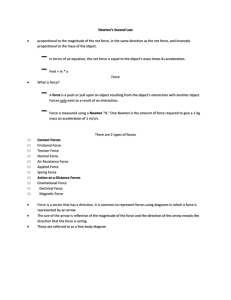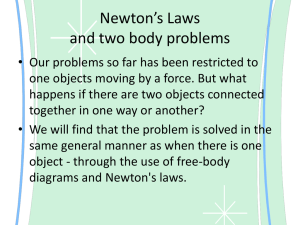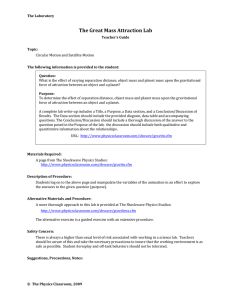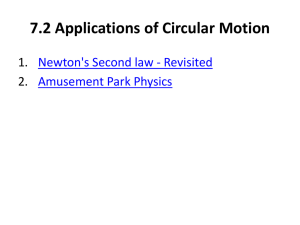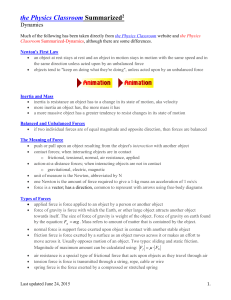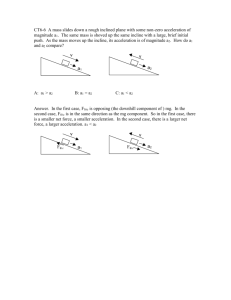Physics Internet Activity: Newton`s Laws of Motion
advertisement
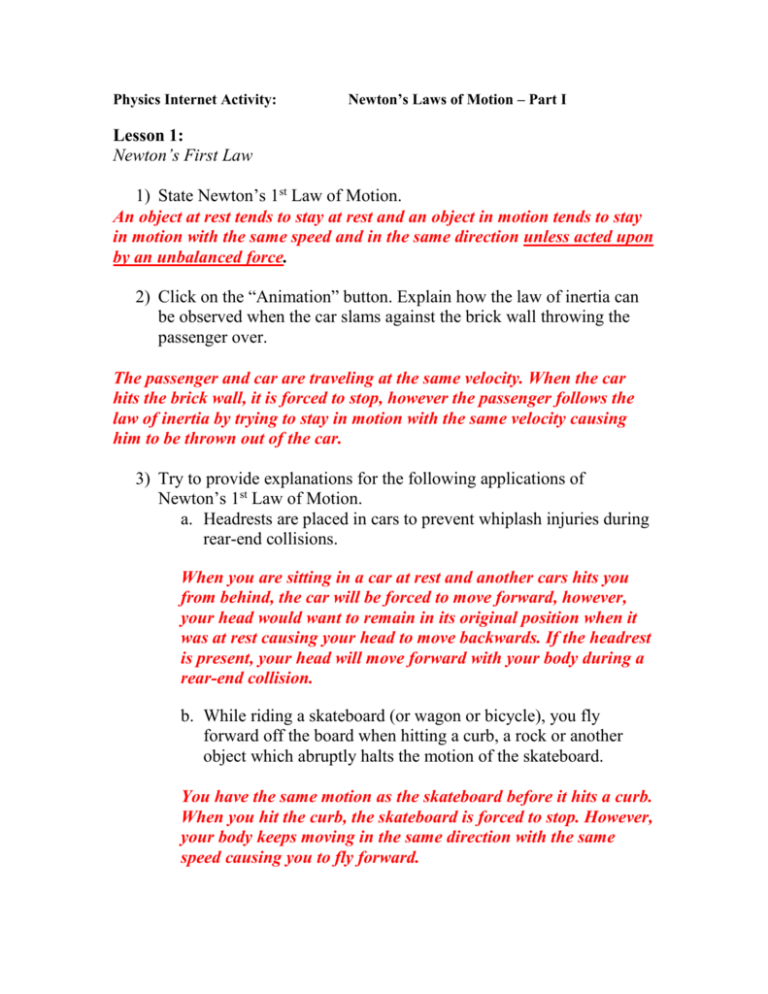
Physics Internet Activity: Newton’s Laws of Motion – Part I Lesson 1: Newton’s First Law 1) State Newton’s 1st Law of Motion. An object at rest tends to stay at rest and an object in motion tends to stay in motion with the same speed and in the same direction unless acted upon by an unbalanced force. 2) Click on the “Animation” button. Explain how the law of inertia can be observed when the car slams against the brick wall throwing the passenger over. The passenger and car are traveling at the same velocity. When the car hits the brick wall, it is forced to stop, however the passenger follows the law of inertia by trying to stay in motion with the same velocity causing him to be thrown out of the car. 3) Try to provide explanations for the following applications of Newton’s 1st Law of Motion. a. Headrests are placed in cars to prevent whiplash injuries during rear-end collisions. When you are sitting in a car at rest and another cars hits you from behind, the car will be forced to move forward, however, your head would want to remain in its original position when it was at rest causing your head to move backwards. If the headrest is present, your head will move forward with your body during a rear-end collision. b. While riding a skateboard (or wagon or bicycle), you fly forward off the board when hitting a curb, a rock or another object which abruptly halts the motion of the skateboard. You have the same motion as the skateboard before it hits a curb. When you hit the curb, the skateboard is forced to stop. However, your body keeps moving in the same direction with the same speed causing you to fly forward. Inertia and Mass 4) You roll a ball down an incline that is 2 meters high on to a flat surface. According to Galileo, when will the ball stop? (Assume friction does not exist.) The ball will stop when it acquires a height of 2 meters or until an outside force (like a wall or person) stops the ball. 5) How is inertia and mass related? Mass is determines the amount of inertia an object has. The larger the mass, the greater the resistance to change. State of Motion 6) Inertia is the tendency of an object to resist acceleration or change in velocity.(2 ways to write the answer) Balanced and Unbalanced Forces 7) When are forces balanced? When are they unbalanced? When all the forces acting upon an object balance each other, the object will be at equilibrium; it will not accelerate. When an object experiences forces that do not balance each other, the object will accelerate. Lesson 2: The Meaning of Force 8) What is force? Give the two types of forces. A force is a push or pull upon an object resulting from the object's interaction with another object. The two types of forces are contact forces and forces resulting from action-at-a-distance. 9) What is a Newton (N)? One Newton is the amount of force required to give a 1-kg mass an acceleration of 1 m/s2. Types of Forces 10) Briefly describe the following forces and include their symbol. a. Applied force An applied force is a force which is applied to an object by another object or by a person. Fapp b. Gravity force The force of gravity is the force with which the earth, moon, or other massive body attracts an object towards itself. By definition, this is the weight of the object. Fgrav c. Normal force The normal force is the support force exerted upon an object which is in contact with another stable object. Fnorm d. Friction force The friction force is the force exerted by a surface as an object moves across it or makes an effort to move across it. The friction force opposes the motion of the object. Ffrict e. Air resistance force Air resistance is a special type of frictional force which acts upon objects as they travel through the air. Fair f. Tension force Tension is the force which is transmitted through a string, rope, or wire when it is pulled tight by forces acting at each end. Ftens g. Spring force The spring force is the force exerted by a compressed or stretched spring upon any object which is attached to it. Fspring Drawing Free-Body Diagrams 11) What are free-body diagrams? How is it similar to vector diagrams? Free-body diagrams are diagrams used to show the relative magnitude and direction of all forces acting upon an object in a given situation. The size of the arrow in a free-body diagram is reflective of the magnitude of the force. The direction of the arrow reveals the direction in which the force acts just like vector diagrams. 12) Draw a free-body diagram for the following: a) A vase sitting on a window sill. b) A large box being pushed rightward by two students. Fnorm Fnorm Ffric Fapp Fgrav Fgrav c) A leaf falling from a tree. Air resistance is a factor. d) A book falling from a top shelf. Ignore air resistance. Fair Fgrav e) A pail being lowered in a well by a rope. Ftens Fgrav f) A hockey puck sliding left on an ice rink slowing down. Fnorm Ffric Fgrav Fgrav Determining the Net Force 13) Using the same rules for finding vector resultants, how would you find the net force on an object? Give at least the two basic rules. If two forces are acting in the same direction, simply add the forces and follow the same direction. If two forces are acting in opposite directions, simply subtract the smaller force from the larger force following the same direction of the larger force. 14) How is the net force related to the acceleration of an object? (Hint: Compare the motion of an object with a net force to the motion of an object with zero net force.) If the net force is zero, the object is either at rest or moving in constant velocity. If a net force is present, the object is accelerating which means velocity is changing. 15) Draw a free-body diagram for the following and determine the net force. a. A 2 N rock is falling. Ignore air resistance. Fgrav = 2 N Fnet = 2 N, downward b. A boy is pushing a sled weighing 500 N rightward with a force of 250 N across the snow. What would be the net force if the friction force is 100 N? Fnorm = 500 N Fnet = 150 N, rightward Ffric = 100 N Fapp = 250 N Fgrav = 500 N c. A sheet of paper weighing 0.001 N is falling from a desk. If the air resistance is 0.0002 N, what would be the net force on the paper? Fair = 0.0002 N Fnet = 0.0008 N, downward Fgrav = 0.001 N d. A teacher is pushing a cabinet with a force of 450 N across the floor. What would be the net force if the cabinet weighed 600 N and the friction force is 450 N? Fnorm = 600 N Fapp = 450 N Ffric = 450 N Fgrav = 600 N Fnet = 0 N
